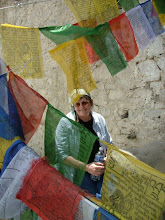
The truth of this proverb strikes you over and over again. Already the retelling of the Iraq war is going on with its different versions and truths: whose story will prevail? And much as we enjoyed the visit to San Xavier on Sunday and the museum yesterday (see below) it is frustrating to find immense gaps in our knowledge of the indigenous peoples and events: even the architects and builders of San Xavier 220 years ago or so (most likely from the local Native American communities) are completely unknown - documentation wasn't a priority even to the Franciscan monks.
James was a succès fou at Kate's school. He stood up in front of a class of mostly hispanic teenagers and answered questions in his English accent, some of which made us giggle when he reported back. Kate showed them pictures of James' school (Repton) and they immediately decided that he had been to Hogwarts. Good naturedly, James recorded a voice mail message for one of the teachers. They wanted him back today, but I think he has done his stint! We have between us seen a little bit of the school system on this visit: on Saturday, we called in to see Zaria's school (St Michael's), where she is in Kindergarten, with a wonderful ex-ballet dancer for her teacher. Zaria's classroom is full of exciting things, including two lizards living in a glass tank, two turtles, and a very well stocked library next door: it's a happy, busy, creative place and Zaria gets far more than the 3Rs, as her enthusiastic teacher plans interesting projects for them to do - the latest is the earth and the planetary system. Freya goes to a pre-school called Second Street, basically a couple of spacious airy classrooms surrounded by a large well equipped playground, with shady spaces for outdoor activities even in the hottest weather.
Yesterday, while James was becoming famous in Tucson, Zaria stayed at home (sore throat and a bit of eye infection) with Oksy and me. We had a quiet morning, sweeping the outside patios, raking up leaves, watering the garden and generally catching up with a bit of housework here and there. Around midday we made our way to the University of Arizona and visited the Arizona Historical Society Museum (Yellow cab: $6.50 for three of us - I haven't sussed out the infrequent buses yet). This is an excellent display, full of interesting artefacts, and well laid out. For most of its recorded history, Arizona's history hasn't been that of the United States, but of its Native American invasions, and its later Hispanic colonial past. The museum has some great pieces of Hispanic furnishings and silverware. Arizona became a state only in 1912 when Tucson's population was probably still under 8,000. By 2009, Tucson's population has multiplied by more than a 100 times to just under a million. Yet more than twenty years before statehood, the University of Arizona was founded here in Tucson, just four years after the legendary shoot out at the OK Corral (1881).
I didn't realise, until I visited this museum, that the US Army used Native Americans to transmit secret messages during WWII and these messages were never decoded. There were about 600 "code talkers" most of them Navajos, but also a handful of Hopi speakers and other ethnic groups. The system was incredibly simple: a word in the Native American language was used to denote its English equivalent: the first letter of the English equivalent was the letter required. Thus to communicate the word "can" a Navajo speaker might have used the following: Moasi (Cat) Wollachee (Ant) Tsah (Needle). But do we have the accounts of the Code talkers themselves of their experiences in WWII - how they had to be protected because they had a faintly oriental look and were subjected to abuse by their fellow Americans? Not as far as I can see. Their stories are not told and their voices are not heard - at least not by us.


No comments:
Post a Comment